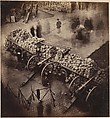Barricades de la Commune, avril 71. Coin de la place Hotel de Ville & de la rue de Rivoli
Pierre-Ambrose Richebourg French
Not on view
After the Franco-Prussian War (1870-71), Parisians revolted against the new government of Adolphe Thiers, who favored a return to royalty. The anti-establishment Government of the Commune of Paris was proclaimed on March 28, 1871, in opposition to Thiers, who had withdrawn to Versailles with the army. The clash led to weeks of fighting, the government's massacre of an estimated 20,000 people, and the burning, by the Communards, of the major public buildings of Paris, including the Tuileries Palace, the Palais Royal, and the Hôtel de Ville (city hall).
Numerous photographs exist of the ruins of Paris after the events of 1871, but Richebourg was one of the few photographers to capture preparations for war: guns propped against one another in makeshift arrangements, cannons rolled into position, carts piled high with cobblestones leaving rough gaps in the paved street. While barricades were generally photographed at street level, Richebourg's image, made from above, offers a detached, formally stunning view. The bold diagonal created by the stone still life of the barricade is countered by the sense of immediacy rendered by the fleeting presence of Communards and observers who moved during exposure.
This image cannot be enlarged, viewed at full screen, or downloaded.

